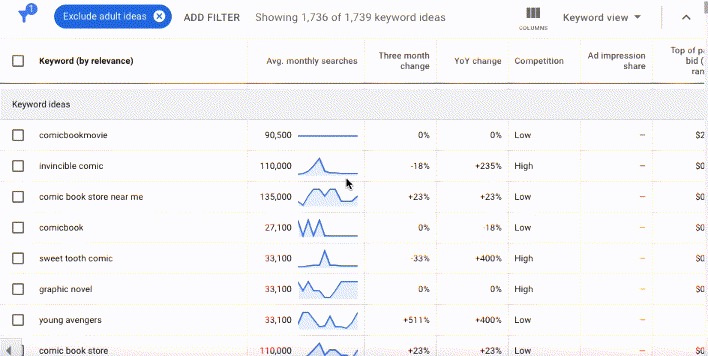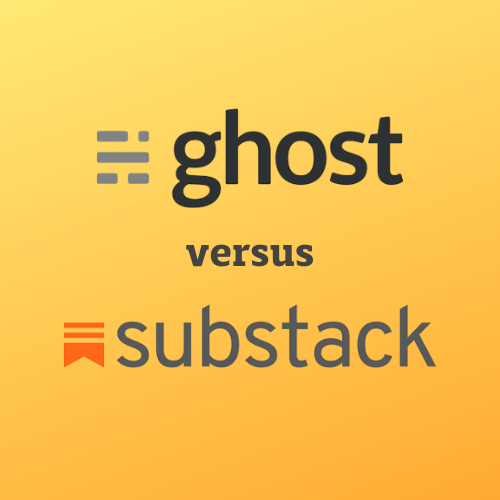A slightly different version of this post originally appeared in the November 5, 2020 issue with the email subject line "So long, Substack, and thanks for all the fish" and a review of text extraction tool TextSniper.
I’ve hinged The Content Technologist — not just the newsletter but the whole consulting business it supports — on the idea that the needs of a business should define software and channel choices, and not the other way around. Substack no longer meets the needs of what my business has become.
Full transparency: All links to Ghost in this newsletter — and from here on out — include my affiliate referral code. For The Content Technologist, I do not receive affiliate income from software referral programs unless I am an active and committed user of the software and the referral income can lessen my operating costs. If you read this, click on my link, and happen to join Ghost afterward, I’ll receive a percentage of your subscription for as long as it’s active. You won’t pay more when you use my link. I absolutely never receive referral income from weekly reviews.
So if you read this and decide Ghost is for you, please click on the link here. It won’t cost you anything, but it will help me run my business and create more great content.
Recent content about Ghost

Why Substack was a great first host of my newsletter
When I first chose Substack, I was drawn to:
- The svelte authorship experience
- The small but growing community of talented writers
- The option to host either free or paid content
- Email newsletter production automation — because sending an email newsletter from scratch is extremely labor-intensive
- Legitimacy from using a platform that other writers I liked were using.
The content format was more or less predefined, but Substack sacrificed features for functionality, and the tech worked reliably. Your audience knew you weren’t going to spam them with endless automated sales pitches. Early subscribers knew that it was not just a mailing list. It was a Substack, the cure for the common newsletter.
![Don Draper rides on a people mover in LAX with a stoic expression. [gif]](https://cdn.substack.com/image/fetch/w_1456,c_limit,f_auto,q_auto:good,fl_progressive:steep/https%3A%2F%2Fbucketeer-e05bbc84-baa3-437e-9518-adb32be77984.s3.amazonaws.com%2Fpublic%2Fimages%2F3ac20555-c941-43d6-b0fb-7d034ae0c695_400x225.gif)
Writers I liked were on Substack. I remain a massive fan of The Margins, Normcore Tech, The Main Event, Deez Links, BIG, and Things That Have Caught My Attention. I also found Office Hours, Medialyte, Branded, and some other less professional newsletters on the platform. It’s a good platform, especially if you only want to write a weekly newsletter and don’t want to manage a website.
From the beginning, though, I knew that Substack’s setup wasn’t archive- or SEO-friendly. Substack publishes all its newsletters on the web, but they’re uncategorized besides reverse chronological order and most popular. Individual posts are nearly impossible to find after you’ve sent about ten newsletters, unless they’re extremely well-organized like Agents and Books. Really, only if you’re Agents and Books.
Building a web archive on Ghost
Since a core part of The Content Technologist newsletter is to educate and inform, a usable archive is imperative. Searchable archives are necessary for an accumulative content approach. In this newsletter, I define concepts that build week after week, or that hop around to a variety of topics, and it can be hard to follow for new subscribers. All subscribers need to be able to access both old and new content.
A year ago I built a website on Ghost to be the well-organized archive of The Content Technologist newsletter. It was an experiment in learning a promising new CMS and an exercise in one of my all-time favorite activities: designing a website from scratch.
With the Ghost CMS, I could present a clear information architecture and split out my newsletter sections into individual articles. I optimized articles on content-technologist.com for search instead of email — separating reviews from essays, trimming the bits that were of the moment, adding more descriptive article titles and tags so they’re fairly easy to find.
Article continued below

Want to find a better way to evaluate your web content performance? Don't just rely on Substack's or Ghost's metrics.
Take Understanding Google Analytics 4 and learn the key metrics and setup that leading website owners and content professionals use to evaluate and plan for content.
Designed especially for non-marketers and non-data scientists, Ghost users AND Substackers.
The period of duplicate content: Posting on both Substack and Ghost
For a few months I published my content twice, once on Substack for the newsletter and once on Ghost for the archive. If you know anything about SEO or content distribution at all, you’ll know that duplicate web content is a big no-no. A search engine doesn’t know what the true source of authority is, and duplicate content can be perceived as a cheat. But I was confident in my ability to canonicalize my pages and manage both systems, at least for a little while.
When the pandemic hit, maintaining two separate content hubs became unsustainable. I abandoned Ghost for the most part; the Substack newsletter was enough to manage.
But the well-organized archive did its job: it gathered organic traffic.
Finding the accidental benefits of an SEO-friendly web archive: Ghost pulls ahead for the win
Let’s start with a data story: a comparison of my organic search traffic on Ghost from April-October 2020 versus my organic traffic on Substack.

Putting the extremely small scale of this traffic trend aside (350 visitors a month is barely needle-moving), the comparative trend is a clear win for Ghost.
Even with ever-expanding new content, Substack attracts minimal organic search traffic each month. Ghost on the other hand is indexed quickly and found easily through search— and I’ve updated my content exactly twice since February.
I expected search engines to pick up the software reviews from my Ghost site. After all, they were buried under an essay in the Substack format. Search engines — heck, all computers along with library visitors — don’t really like content with different subjects stacked with no real metadata or definition.
More surprising: Search engines picked up and indexed the Ghost version of the exact same essays that ran on Substack. Even when I’d published the essay on Substack months earlier.
Sometime around April my Ghost site started to rank well for an essay about Netflix KPIs I’d posted on both platforms in January. Google loved my succinct prose enough to algorithmically passage out its own meta description. Evidently readers liked the essay when they clicked through because it’s still ranking toward the top for a variety of queries like “Netflix KPI.”

This single post, buried in my archive, is the number one driver of traffic to The Content Technologist. It’s the only post I’ve ever written about Netflix and one of maybe three I’ve published about entertainment content. It’s an anomaly as far as my content goes — I focus on web content versus entertainment brands — but the small success is proof that well-written content from a relatively unknown brand can be picked up by Google, even in a saturated search market, even in 2020.
Although the Netflix KPI post is only tangential to one of my core content pillars, I know I can optimize it. You bet I’m reupholstering that post with some links, a more attractive call to action, and a membership sign-up on the same domain. I’m going to design a collection around all the analytics content, sprinkling in context and drawing connections between different posts. I’ll add a few more collections for other pillars, prep some new content, make a sustainable schedule for content maintenance…
![Cher from Clueless says, "Let's do a makeover!" and Dionne's face lights up. [gif]](https://cdn.substack.com/image/fetch/w_1456,c_limit,f_auto,q_auto:good,fl_progressive:steep/https%3A%2F%2Fbucketeer-e05bbc84-baa3-437e-9518-adb32be77984.s3.amazonaws.com%2Fpublic%2Fimages%2F60784a3c-9d14-407d-ab8e-55601cdd0682_480x270.gif)
If I’m getting organic search traffic on a one-off post living on a barely updated site that’s minimally optimized, imagine what can happen when I actually try.
I like you, Substack, but you haven’t provided much in the way of organic growth — either in search engines or through your platform. So I’ve chosen Ghost.
For the digital strategy nerds: a reminder that organic acquisition is always easier
One of the easiest ways to build a sustainable independent media business is to succeed in organic search. If you’re halfway cognizant of writing to meet audience needs and know how to optimize for readers, SEO traffic is a boon for new subscribers.
Legacy media brands don’t often know how to use SEO properly, which is why so many online writers wind up with a bad relationship with the entire idea of optimization. But trust me: organic search is the best connector to the people who want to read what you write.
I encourage my clients to focus on organic (inbound) content rather than advertising (outbound) all the time. Passive traffic income is so much easier than the repetitive churn of asking for subscribers through fleeting ads or social platforms. Frankly, I’m tired of being sold to and I’m tired of selling in 2020. Organic traffic removes that pressure to sell. I’d rather spend my time building relationships.
Organic search is a better fit for the audience I’m building: content strategists, web professionals, tech-savvy writers and marketers who want to make content better and are actively looking for solutions. On a newsletter-only platform like Substack, my content may not be useful to an audience right away, since I get deep into specifics and nitty-gritty tactics that most content strategists use maybe once or twice a year.
When my audience needs to pick up what I’m putting down, I want them to find a good resource. Ideally that resource would attract audiences from both referrals and search engines.
What I like about Ghost
I’ve also enjoyed the experience of working with Ghost over the past year. It’s a content management system that centers all the parts I love about making websites. I choose to purchase the managed services through Ghost(Pro), although you can always install the Ghost CMS on your own service provider and handle the back-end yourself. The out-of-the-box free Ghost CMS has great features, which include:
- Focus on the writing experience with the option to add code when needed
- Free and paid membership built into the CMS
- A healthy selection of themes that I can customize with my limited coding knowledge
- A flexible tagging system
- Integrations with other common website software like Typeform and my preferred writing software Ulysses
The paid version of Ghost(Pro) additionally:
- Handles the back-end architecture — site speed, security and functionality are all covered with my monthly membership
- Lets me use my custom domain through my normal web services provider (MediaTemple, which hosts all the domains I buy but never use)
- Personalized, supportive customer service that has been just lovely. (Substack’s service, for its user base, is totally fine and I have no complaints. I know I’m paying for service here)
As with all content management systems, Ghost has its quirks. My quick success with Ghost is extremely dependent on the fact that I’m a content strategist — I know how to manage tags, information architecture, and metadata. I know the many ways one can fuck up a website and I’m careful to avoid them.
I’m well aware that I pay for Ghost(Pro) and I’ve been using Substack for free. But the fixed fees for Ghost are far easier for me to swallow when I know I’m getting site speed, security, and most importantly, discoverability in return.
Talkin shit about a pretty Substack…
Meanwhile, Substack still has that lovely writing experience, but growing organic subscriptions for my free content should be easier on the platform itself. Other than one or two more referrals from potentially being featured on the site, I don’t see how my subscriber acquisition strategy would change if I launched a paid subscription program there.
When the recent oversaturation of writers hopping on the newsletter bandwagon meets Substack’s near void of structured data, it’s extremely difficult to discover other newsletters. Did you know that new Substacks are so hard to find, there is now a Substack newsletter specifically devoted to recommending other Substack newsletters?
I had hoped Substack would build out its recommendation and discovery modules in the past year, but it hasn’t. Give us some wayfinding guidelines, some categorization and metadata. We need some Geocities addresses, y’all.
It’s not just that the Substack platform doesn’t optimize for sustainable independent growth; it’s also their business strategy of scaling on bylines and short-term takes rather than in-depth content and community.
In the past few months, Substack has prioritized poaching known bylines, and that whole approach gives me the heebie-jeebies. The winners in Known Media Name culture hyperbolize to the point of malice and draw from all the worst tendencies of tv news and hustle culture combined. I’ve spent my career avoiding the status quo-hards who enjoy mediocre bloviating like Matt Taibbi and Andrew Sullivan, and I don’t want to be on the same platform competing for subscription dollars and customer service with those bedbugs. The nail in the coffin came after Betsy Reed’s scathing assessment of Glenn Greenwald’s next move.** The whole platform is on the verge of becoming Large Adult Twitter, as Ben Smith pointed out this week. It’s not really an audience-focused media model if the same people from 15 years ago are building their fortunes on attention and eyeballs.
Clearly I can talk some shit, but I don’t want to be lumped in with a platform that’s synonymous with gossip. All that negativity gets me down, man.
I’ll leave those gripes right here, but I want to support companies whose business strategy I can get behind and who are passionate about the new possibilities and the future of content. Ghost’s CMS is specifically designed for independent publishers like me. I’d prefer to build my own brand and continue writing about nerdy technical topics while developing my voice as a writer.
In the end it’s a business decision
It is far easier to attract subscribers on Ghost. I can make more money on Ghost than I can on Substack, and I get to manage a website, which is one of my favorite things in the whole world.
And look — you might be one of those people who hates Google and doesn’t want to rely on Google SEO for their business. But Google’s organic search POV has always been to help better content appear in search results. They’ve consistently updated their discovery algorithms for the better and are far less capricious and more transparent than the social networks when it comes to updates. (More on my complicated but mostly positive feelings about Google.)
People searching for content marketing, SEO and UX information use web search. I’m going to use the superpowered free discovery services that Google and Bing provide.
You might want to switch your Substack, Patreon or other gated subscription content to Ghost if:
- Your content is accumulative: you cover complex topics that often refer to each other and sometimes require deeper context
- You want to preserve your content in a searchable archive with a clear information architecture
- You want to have more control over how your content is presented and maintained
- You’re somewhat tech-savvy, or you were once
- You want to move beyond building a portfolio and develop a media brand
- You like websites and don’t mind managing one
- You don’t want to manage plugins or web security for a full self-build site on WordPress or another platform
- You want to rely exclusively on subscriber or native advertising revenue, rather than banner ads (you might be able to put these on ghost but why?)
- You don’t mind working with a growing platform with good but fairly limited features
- You have some basic basic knowledge of HTML and CSS — or you don’t mind paying someone to help you learn how to add and tweak your preferences
As I’m transitioning fully to Ghost, I’ll be documenting my full process and creating a guide for anyone who wants to do the same.
It’s been a good run, but I’m stopping to catch my breath and change my route a little. Here’s hoping you’ll join me for the next phase.
If you read this whole essay, you will absolutely love The Content Technologist newsletter:
Hand-picked related articles





